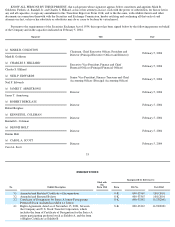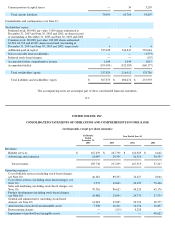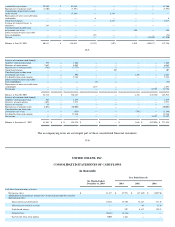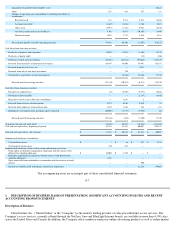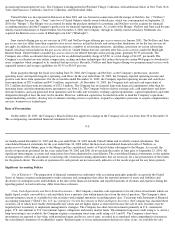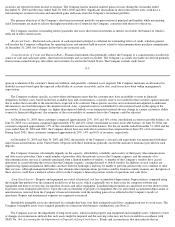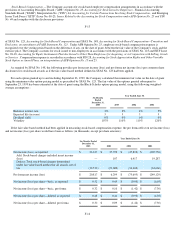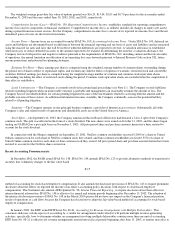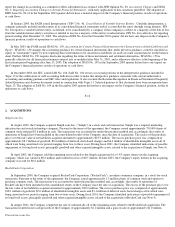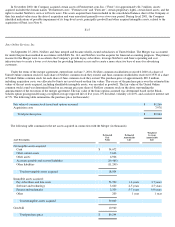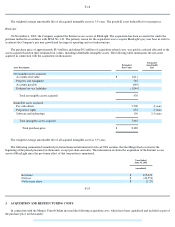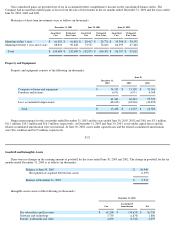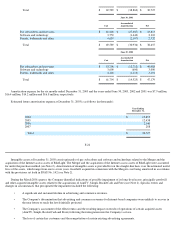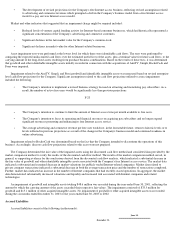Classmates.com 2003 Annual Report Download - page 51
Download and view the complete annual report
Please find page 51 of the 2003 Classmates.com annual report below. You can navigate through the pages in the report by either clicking on the pages listed below, or by using the keyword search tool below to find specific information within the annual report.
evidence of an arrangement exists, (ii) delivery has occurred or services have been rendered, (iii) the fee is fixed or determinable and
(iv) collectibility is reasonably assured.
Billable services revenues are recognized in the period in which fees are fixed or determinable and the related products or services are
provided to the user. The Company's pay subscribers generally pay in advance for their service by credit card, and revenue is then recognized
ratably over the period in which the related services are provided. Advance payments from users are recorded on the balance sheet as deferred
revenue. The Company offers alternative payment methods to credit cards for certain pay service plans. These alternative payment methods
currently include electronic check payment, payment by personal check or money order or through a local telephone company. In
circumstances where payment is not received in advance, revenue is only recognized if collectibility is reasonably assured.
Advertising and commerce revenues primarily consist of fees from Internet search partners that are generated as a result of users utilizing
partner Internet search services, fees generated by users viewing and clicking on third-party Web site banners and text-
link advertisements, fees
generated by enabling customer registrations for partners and fees from referring users to, or from users making purchases on, sponsors' Web
sites. Revenues are recognized provided that no significant obligations remain, fees are fixed or determinable, and collection of the related
receivable is reasonably assured. The Company recognizes banner advertising and sponsorship revenues in the periods in which the
advertisement or sponsorship placement is displayed, based upon the lesser of (i) impressions delivered divided by the total number of
guaranteed impressions or (ii) ratably over the period in which the advertisement is displayed. The Company's obligations typically include a
minimum number of impressions or the satisfaction of other performance criteria. Revenue from performance-based arrangements, including
referral revenues, is recognized as the related performance criteria are met. In determining whether an arrangement exists, the Company
ensures that a binding contract is in place, such as a standard insertion order or a fully executed customer-specific agreement. The Company
assesses whether performance criteria have been met and whether the fees are fixed or determinable based on a reconciliation of the
performance criteria and the payment terms associated with the transaction. The reconciliation of the performance criteria generally includes a
comparison of internally tracked performance data to the contractual performance obligation and to third-party or customer
F-12
performance data in circumstances where that data is available. Probability of collection is assessed based on a number of factors, including
past transaction history with the customer and the creditworthiness of the customer. If it is determined that collection is not reasonably assured,
revenue is not recognized until collection becomes reasonably assured, which is generally upon receipt of cash.
Cost of Billable Services —Cost of billable services includes direct costs of billable services and costs that have been allocated to billable
services based on the aggregate hourly usage of pay subscribers as a percentage of total hours used by active users. Direct costs consist of costs
related to providing technical support, customer billing and billing support to pay subscribers. Allocated costs consist primarily of
telecommunications and data center costs, personnel and overhead-related costs associated with operating the Company's network and data
centers, and depreciation of network computers and equipment.
Cost of Free Services —
Cost of free services includes direct costs incurred in providing certain technical and customer support services to
free access users as well as costs that have been allocated to free services based on the aggregate hourly usage of free access users as a
percentage of total hours used by the Company's active access users. Allocated costs consist primarily of telecommunications and data center
costs, personnel and overhead-related costs associated with operating the Company's network and data centers, and depreciation of network
computers and equipment.
Sales and Marketing —Sales and marketing expenses include advertising and promotion expenses, fees paid to distribution partners to
acquire new pay subscribers, personnel-related expenses for sales and marketing personnel and telemarketing costs incurred to acquire pay
subscribers, retain pay subscribers and up sell pay subscribers to add-on services, such as our accelerated dial-up services. The Company has
expended significant amounts on sales and marketing, including national branding campaigns comprised of television, Internet, sponsorships,
radio, print and outdoor advertising. Marketing and advertising costs to promote the Company's products and services are expensed in the
period incurred. Advertising and promotion expenses include media, agency and promotion expenses. Media production costs are expensed the
first time the advertisement is run. Media and agency costs are expensed over the period the advertising runs. Advertising and promotion
expense for the six months ended December 31, 2003 and the years ended June 30, 2003, 2002 and 2001 was $57.6 million, $67.7 million,
$25.4 million and $40.3 million, respectively.
Product Development Costs —Product development expenses include expenses for the maintenance of existing software and the
development of new or improved software and technology, including personnel-related expenses for the software engineering department and
the costs associated with operating the Company's facility in India. Costs incurred by the Company to develop, enhance, manage, monitor and
operate the Company's services are generally expensed as incurred, except for certain costs relating to the acquisition and development of
internal-use software that are capitalized and depreciated over their estimated useful lives, generally three years or less.
General and Administrative —General and administrative expenses include personnel-related expenses for executive, finance, legal,
human resources and internal customer support personnel. In addition, general and administrative expenses include fees for professional legal
and accounting services, non-income taxes, insurance, and occupancy and other overhead-related costs, as well as the expenses incurred and
credits received as a result of certain legal settlements.


